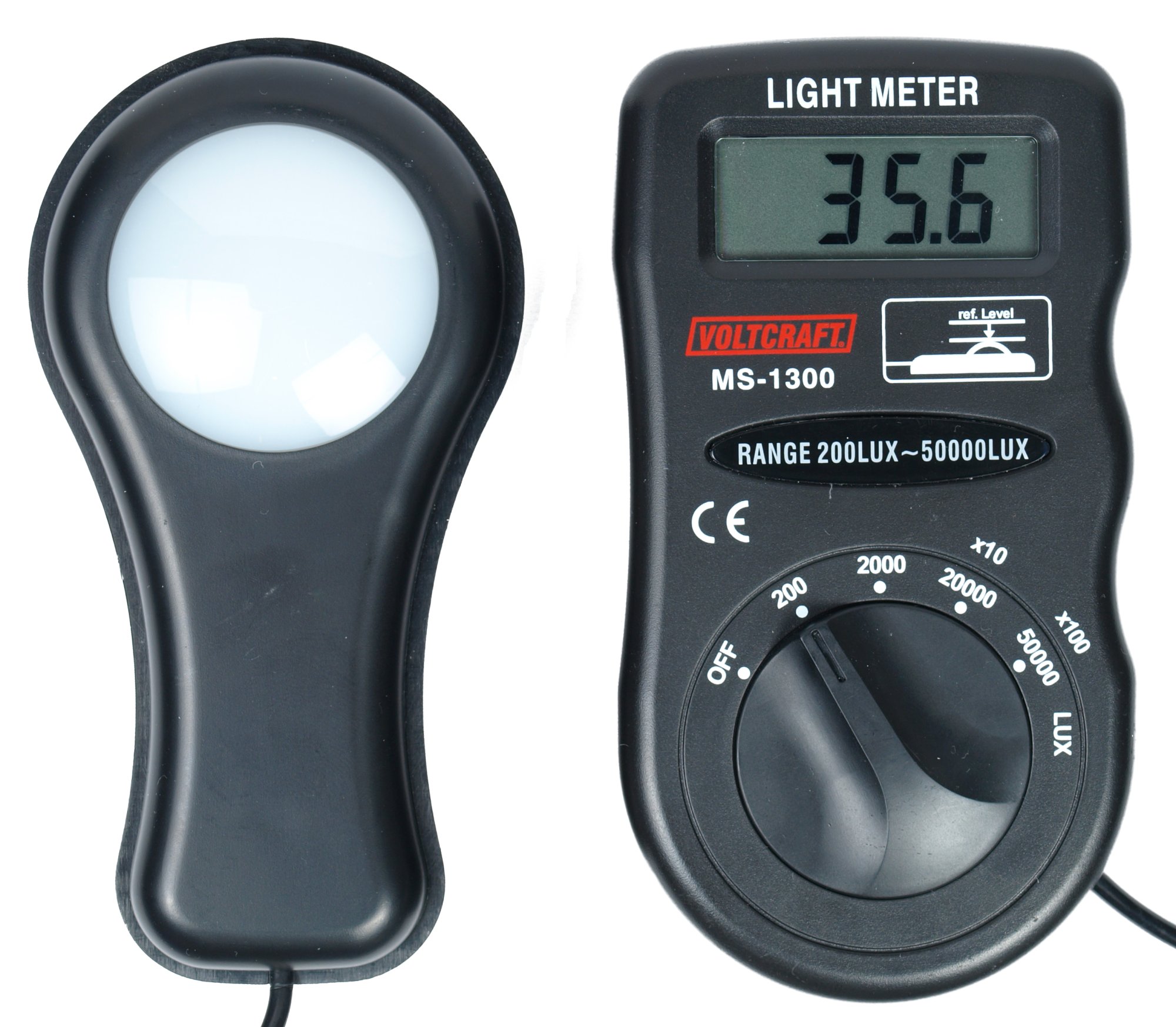|
Luminous Flux
In photometry, luminous flux or luminous power is the measure of the perceived power of light. It differs from radiant flux, the measure of the total power of electromagnetic radiation (including infrared, ultraviolet, and visible light), in that luminous flux is adjusted to reflect the varying sensitivity of the human eye to different wavelengths of light. Units The SI unit of luminous flux is the lumen (lm). One lumen is defined as the luminous flux of light produced by a light source that emits one candela of luminous intensity over a solid angle of one steradian. 1\ \text = 1\ \text \times 1\ \text In other systems of units, luminous flux may have units of power. Weighting The luminous flux accounts for the sensitivity of the eye by weighting the power at each wavelength with the luminosity function, which represents the eye's response to different wavelengths. The luminous flux is a weighted sum of the power at all wavelengths in the visible band. Light outside the ... [...More Info...] [...Related Items...] OR: [Wikipedia] [Google] [Baidu] |
Lumen (unit)
The lumen (symbol: lm) is the SI unit of luminous flux, which quantifies the perceived power of visible light emitted by a source. Luminous flux differs from power (radiant flux), which encompasses all electromagnetic waves emitted, including non-visible ones such as thermal radiation (infrared). By contrast, luminous flux is weighted according to a model (a " luminosity function") of the human eye's sensitivity to various wavelengths; this weighting is standardized by the CIE and ISO. The lumen is defined as equivalent to one candela-steradian (symbol cd·sr): : 1 lm = 1 cd·sr. A full sphere has a solid angle of 4π steradians (≈ 12.56637 sr), so an isotropic light source (that uniformly radiates in all directions) with a luminous intensity of one candela has a total luminous flux of :. One lux is one lumen per square metre. Explanation If a light source emits one candela of luminous intensity uniformly across a solid angle of one steradian, the total luminous flux e ... [...More Info...] [...Related Items...] OR: [Wikipedia] [Google] [Baidu] |
Weighting
The process of frequency weighting involves emphasizing the contribution of particular aspects of a phenomenon (or of a set of data) over others to an outcome or result; thereby highlighting those aspects in comparison to others in the analysis. That is, rather than each variable in the data set contributing equally to the final result, some of the data is adjusted to make a greater contribution than others. This is analogous to the practice of adding (extra) weight to one side of a pair of scales in order to favour either the buyer or seller. While weighting may be applied to a set of data, such as epidemiological data, it is more commonly applied to measurements of light, heat, sound, gamma radiation, and in fact any stimulus that is spread over a spectrum A spectrum (: spectra or spectrums) is a set of related ideas, objects, or properties whose features overlap such that they blend to form a continuum. The word ''spectrum'' was first used scientifically in optics t ... [...More Info...] [...Related Items...] OR: [Wikipedia] [Google] [Baidu] |
Light-emitting Diode
A light-emitting diode (LED) is a semiconductor device that emits light when current flows through it. Electrons in the semiconductor recombine with electron holes, releasing energy in the form of photons. The color of the light (corresponding to the energy of the photons) is determined by the energy required for electrons to cross the band gap of the semiconductor. White light is obtained by using multiple semiconductors or a layer of light-emitting phosphor on the semiconductor device. Appearing as practical electronic components in 1962, the earliest LEDs emitted low-intensity infrared (IR) light. Infrared LEDs are used in remote-control circuits, such as those used with a wide variety of consumer electronics. The first visible-light LEDs were of low intensity and limited to red. Early LEDs were often used as indicator lamps, replacing small incandescent bulbs, and in seven-segment displays. Later developments produced LEDs available in visible, ultraviolet (U ... [...More Info...] [...Related Items...] OR: [Wikipedia] [Google] [Baidu] |
Photometry Radiometry Units
{{disambig ...
Photometry can refer to: * Photometry (optics), the science of measurement of visible light in terms of its perceived brightness to human vision * Photometry (astronomy), the measurement of the flux or intensity of an astronomical object's electromagnetic radiation * A photometric study, sometimes also referred to as a lighting "layout" or "point by point" See also * Photogrammetry * Radiometry Radiometry is a set of techniques for measurement, measuring electromagnetic radiation, including visible light. Radiometric techniques in optics characterize the distribution of the radiation's power (physics), power in space, as opposed to phot ... [...More Info...] [...Related Items...] OR: [Wikipedia] [Google] [Baidu] |
Photometer
A photometer is an instrument that measures the strength of electromagnetic radiation in the range from ultraviolet to infrared and including the visible spectrum. Most photometers convert light into an electric current using a photoresistor, photodiode, or photomultiplier. Photometers measure: *Illuminance * Irradiance * Light absorption * Scattering of light * Reflection of light *Fluorescence *Phosphorescence * Luminescence Historically, photometry was done by estimation, comparing the luminous flux of a source with a standard source. By the 19th century, common photometers included Rumford's photometer, which compared the depths of shadows cast by different light sources, and Ritchie's photometer, which relied on equal illumination of surfaces. Another type was based on the extinction of shadows. Modern photometers utilize photoresistors, photodiodes or photomultipliers to detect light. Some models employ photon counting, measuring light by counting individual photons. ... [...More Info...] [...Related Items...] OR: [Wikipedia] [Google] [Baidu] |
Goniophotometer
A Goniophotometer is a device used for measurement of the light emitted from an object at different angles. The use of goniophotometers has been increasing in recent years with the introduction of LED-light sources, which are mostly directed light sources, where the spatial distribution of light is not homogeneous. If a light source is homogeneous in its distribution of light, it is called a Lambertian source. Due to strict regulations, the spatial distribution of light is of high importance to automotive lighting and its design. Uses A goniophotometer can be used for various applications: * Measurement of luminous flux of a light source * Measurement of luminous intensity distribution from a source much smaller than the size of the goniophotometer Equipped with Colorimetry, color sensors additional characteristics can be measured * Distribution of correlated color temperature * Color uniformity Types The goniophotometer types A, B, and C defined here are derived from publicatio ... [...More Info...] [...Related Items...] OR: [Wikipedia] [Google] [Baidu] |
Integrating Sphere
An integrating sphere (also known as an Ulbricht sphere) is an optical component consisting of a hollow spherical cavity with its interior covered with a diffuse reflection, diffuse white reflective coating, with small holes for entrance and exit ports. Its relevant property is a uniform scattering or diffusing effect. Light rays incident on any point on the inner surface are, by multiple scattering reflections, distributed equally to all other points. The effects of the original direction of light are minimized. An integrating sphere may be thought of as a diffuser (optics), diffuser which preserves power but destroys spatial information. It is typically used with some light source and a detector for optical power measurement. A similar device is the focusing or Coblentz sphere, which differs in that it has a mirror-like (specular) inner surface rather than a diffuse inner surface. In 1892, W. E. Sumpner published an expression for the throughput of a spherical enclosure with di ... [...More Info...] [...Related Items...] OR: [Wikipedia] [Google] [Baidu] |
Brightness
Brightness is an attribute of visual perception in which a source appears to be radiating/reflecting light. In other words, brightness is the perception dictated by the luminance of a visual target. The perception is not linear to luminance, and relies on the context of the viewing environment (for example, see White's illusion). Brightness is a subjective sensation of an object being observed and one of the color appearance parameters of many color appearance models, typically denoted as Q. Brightness refers to how much light ''appears to shine'' from something. This is a different perception than lightness, which is how light something appears ''compared to'' a similarly lit white object. The adjective '' bright'' derives from an Old English '' beorht'' with the same meaning via metathesis giving Middle English ''briht''. The word is from a Proto-Germanic ', ultimately from a PIE root with a closely related meaning, *' "white, bright". "Brightness" was formerly used as a ... [...More Info...] [...Related Items...] OR: [Wikipedia] [Google] [Baidu] |
Lamp (electrical Component)
Electric light is an artificial light source powered by electricity. Electric Light may also refer to: * Light fixture, a decorative enclosure for an electric light source * Electric Light (album), ''Electric Light'' (album), a 2018 album by James Bay * Electric Light (poetry), a poetry collection by Irish poet Seamus Heaney, 2001 * Electric Light (song), "Electric Light" (song), a 2008 song by Infernal {{disambig ... [...More Info...] [...Related Items...] OR: [Wikipedia] [Google] [Baidu] |
Light
Light, visible light, or visible radiation is electromagnetic radiation that can be visual perception, perceived by the human eye. Visible light spans the visible spectrum and is usually defined as having wavelengths in the range of 400–700 nanometres (nm), corresponding to frequency, frequencies of 750–420 terahertz (unit), terahertz. The visible band sits adjacent to the infrared (with longer wavelengths and lower frequencies) and the ultraviolet (with shorter wavelengths and higher frequencies), called collectively ''optical radiation''. In physics, the term "light" may refer more broadly to electromagnetic radiation of any wavelength, whether visible or not. In this sense, gamma rays, X-rays, microwaves and radio waves are also light. The primary properties of light are intensity (physics), intensity, propagation direction, frequency or wavelength spectrum, and polarization (waves), polarization. Its speed of light, speed in vacuum, , is one of the fundamental physi ... [...More Info...] [...Related Items...] OR: [Wikipedia] [Google] [Baidu] |
International Organization For Standardization
The International Organization for Standardization (ISO ; ; ) is an independent, non-governmental, international standard development organization composed of representatives from the national standards organizations of member countries. Membership requirements are given in Article 3 of the ISO Statutes. ISO was founded on 23 February 1947, and () it has published over 25,000 international standards covering almost all aspects of technology and manufacturing. It has over 800 technical committees (TCs) and subcommittees (SCs) to take care of standards development. The organization develops and publishes international standards in technical and nontechnical fields, including everything from manufactured products and technology to food safety, transport, IT, agriculture, and healthcare. More specialized topics like electrical and electronic engineering are instead handled by the International Electrotechnical Commission.Editors of Encyclopedia Britannica. 3 June 2021.Inte ... [...More Info...] [...Related Items...] OR: [Wikipedia] [Google] [Baidu] |
Human
Humans (''Homo sapiens'') or modern humans are the most common and widespread species of primate, and the last surviving species of the genus ''Homo''. They are Hominidae, great apes characterized by their Prehistory of nakedness and clothing#Evolution of hairlessness, hairlessness, bipedality, bipedalism, and high Human intelligence, intelligence. Humans have large Human brain, brains, enabling more advanced cognitive skills that facilitate successful adaptation to varied environments, development of sophisticated tools, and formation of complex social structures and civilizations. Humans are Sociality, highly social, with individual humans tending to belong to a Level of analysis, multi-layered network of distinct social groups — from families and peer groups to corporations and State (polity), political states. As such, social interactions between humans have established a wide variety of Value theory, values, norm (sociology), social norms, languages, and traditions (co ... [...More Info...] [...Related Items...] OR: [Wikipedia] [Google] [Baidu] |





